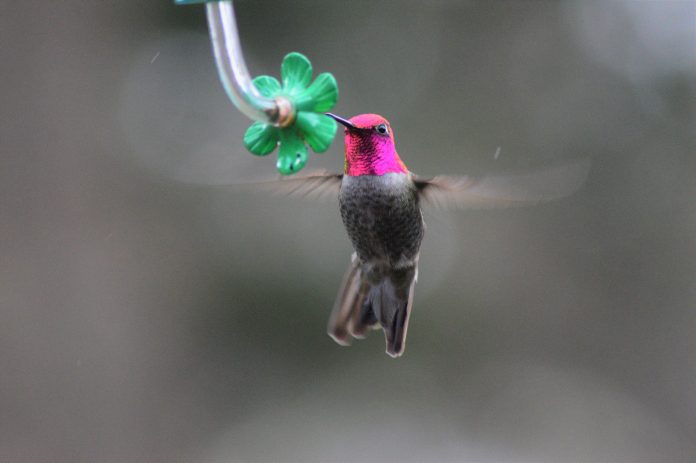Originally, this was going to be a column for late August saying DON’T take your hummingbird feeders down on Labor Day. Instead, it turned into a column saying DO put your hummingbird feeders up now, and be sure to keep them clean.
Do feed the birds
“There’s this misconception that birds become dependent on feeders,” said Jamey Emmert, wildlife communications specialist for the ODNR Division of Wildlife District 3 office, and self-confessed bird nerd. “Feeders are not going to prevent them from migrating or make them come back too soon.”
That’s because the feeders just supplement their diets, which in the case of hummingbirds consist mostly of insects.
“Feeding them is so much fun, but they mainly need protein,” Emmert said. “The sugar just helps keep their bodies moving and gives them energy to feed their young and hunt for insects and spiders.”
She said it’s important that they get sugar — not honey — at a ratio of four parts water to one part sugar. She always dumps the sugar into boiling water to dissolve it. The nectar can then be stored in the refrigerator for up to a week.
You can purchase pre-made nectar, but it’s important to note that the red color is not needed to attract hummingbirds: the red plastic of the feeders is enough. More dye-free nectars are being sold because there’s some thought that red coloring may harm the birds.
Keep it clean
One thing that is known to harm the birds is failing to clean the feeders regularly. The sugar solution gets moldy, which can make the birds sick, said Adam Zorn, program manager for the University of Mount Union’s John T. Huston — Dr. John D. Brumbaugh Nature Center.
“Bird feeding is fun, but you have to make sure the feeder is clean and relatively sterile,” he said. “That may mean changing the fluid every day, or at most, every other day in hot weather. If it becomes cloudy, you know there’s stuff growing in it.”
Zorn said his mother, aunts and grandparents always used Mother’s Day as the target date to put up feeders. But hummingbirds can be seen here in mid-April — although those are not necessarily the ones that live here.
Hummingbirds have site fidelity, meaning they tend to come back to the same woods, or the same backyard, to nest and mate.
Just passing through
Yet the first ones we see here may be just passing through. Ruby-throated hummingbirds, for instance, have a range that extends 500 miles north of the United States into Canada. So the first hummingbirds you see may not stay, Zorn said.
The eBird.org website, a project of Cornell University’s Lab of Ornithology, has up-to-date maps that show where hummingbirds and other species have been sighted.
They are currently in the southern United States, moving north. Though some winter in the extreme southern states, like Florida, most spend the cold months in southern Mexico, Central America or South America.
And again, it is not necessary to take hummingbird feeders down by Labor Day.
“Leave feeders up as long as you continue to see them; it’s not going to keep them here,” Zorn said. “Sometimes you can see hummingbirds through early October. They don’t all get up and leave at the same time.”
Ideal feeders
The type of feeder is also important, he said. The typical one sold in stores looks like a tall jar with flowers around the bottom. Those can leak, plus gravity lets the nectar flow right into the feeder ports, attracting ants, yellow jackets and wasps.
Zorn uses feeders that have a saucer with a lid. There is a gap between the feeder port and the liquid that the long tongues of hummingbirds can reach, but not swarming insects.
There are “ant moats” that are sometimes built into the feeder, or that you can buy separately. But they have to be refilled frequently when it’s hot because the water evaporates, Zorn said. He prefers ant guards that look like bells and contain insect repellent.
Emmert watches the maps on eBird to see where the hummingbirds are, and when she might see them in her backyard in Akron. She also uses allaboutbirds.org, another Cornell ornithology lab site, which gives tips on feeding and housing birds and identifying different species.
Flowers
In addition to the feeders, she and her husband, Greg, plant flowers that attract hummingbirds. Columbine blooms early, so it’s good for those first visitors, while cardinal flowers “pop” in June and July, in time for the hummingbirds’ peak activity, Emmert said.
They also plant blazing star, with flowers that look like feather boas. Hummingbirds like the nectar, but the flowers also attract bugs. “The birds just fly around, snatching up the bugs,” she said. “They’re so much fun to watch.”














My grandpa has been feeling extremely lonely in his apartment ever since the pandemic started because he hasn’t been able to see very many people, so I am thinking about getting him a hummingbird feeder. He loves birds and interacting with nature, so this could be a great way to raise his spirits. Thanks for explaining that it’s important to keep the feeder clean and sterile by changing the fluid every day.